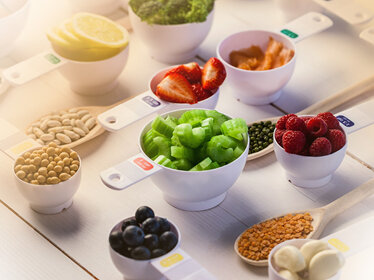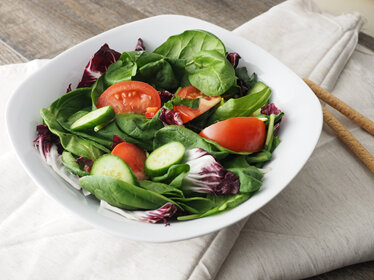Your hands are an easy to use guide to portion size. As portion size is different to serving sizes on labels (and these can vary greatly for the same food item), these general guidelines are easy to visualise and implement.
Use the palm of your hand (excluding fingers) and the thickness of your hand to determine the portion of meat or protein.
A clenched fist is the size of a carbohydrate portion.
Two cupped hands is the portion size of vegetables or salad.
Portion control can be difficult due to the many scenarios which involve eating and making food choices so helpful tips are suggested for a few of those times in everyday life when portions can become larger than necessary.

Optical illusion - Eat off a smaller sized plate, it gives the illusion of a full plate of food but less is actually being eaten.
Greens go first - By serving up the vegetables and salad first there is less room on the plate for the other components of the meal.
Serve a meal for tomorrow - Dish up extras from your dinner meal into containers to take for lunch the next day and put it in the fridge. This not only means you eat a correct portion size; it eliminates food wastage and makes organising lunch for the next day easy.
Plan ahead - Meals planned in advance mean it is easier to control your portions as you are in charge of what you consume.
Choose colourful meals - This can mean the vegetable or salad content is higher
Ask for a lettuce 'burger bun', opt for wrap options where applicable or ask to have excess bread removed from your sub or sandwich.
Get a salad on the side and eat it first!

Swap the starches - Opt for vegetables, side salad or steamed rice instead of deep fried wedges or chips.
Don’t eat too much meat - Remember a portion of meat is the palm of your hand or between 120-190g depending on the person so if it’s a very large portion, request a smaller amount.
Avoid 'all you can eat' - Whilst the value is tempting this is a portion-controlled disaster, where overeating is likely to occur.
Liquid calories count - Be mindful of all liquids consumed other than water as they all have calories connected and can impact portions of other foods.
Ask for two spoons - Split dessert with a friend, not only does it mean your portions are controlled without often a small taste of something decadent is all you need at the end of a meal.
Eat slowly - Allow time for your stomach to signal to your brain that it’s full (this usually takes around 20 minutes from first bite). If you eat quickly, not only will you overeat but your digestion is also negatively affected.
Eat mindfully - Consume your meals at a table away from modern day distractions such as TVs, phones or computers. These activities sap concentration and therefore can distrupt the full signals being sent to the brain again causing overeating.
Sources:
New Zealand Listener 2015
Healthy Food Guide NZ March 2013
Heart Foundation NZ